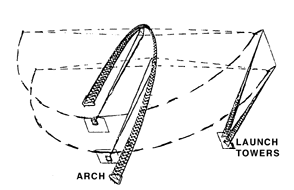
Xtreme
SkyFlier
You do not need to ride this attraction.
Equipment needed:
Find the "Spot" on the bridge over Whitewater Falls. It is near the top of the exit ramp at the western edge of the splash zone. Look for the splash zone sign on a post. From this spot the arch is seen edge-on and the Xtreme SkyFlyer looks something like the diagram below. Near the "Spot" there is a sign giving important data. Copy this data from the sign:

Measurements from the "Spot":
1) Measure the angular height (angular altitude) from the horizon to the riders just before they start their fall. ______2) Measure the angular height from closest blue loading box to point where the supporting cables attach to the horizontal supporting rod near the top of the arch. Since you cannot see this supporting rod from the view point, you will have to estimate its location by observing the cables supporting the riders when they have been pulled toward the launch tower. _____
3) Hold the horizontal accelerometer at arms length in front of you. Use it to measure the angle from the horizontal to the cable when the riders reach the highest point on their first swing. __________
4) Measure the period of the swing in seconds.________
Calculations: (Attach your work to this paper.)
Q1. Calculate the height of the riders just before they are released.Q2. If the total mass of the three riders is 160 kg, what is their gravitational potential energy at the moment of release?
Q3. Calculate the length, 1, of the pendulum cables. (Assume that there is only one cable.) Use measurement (2).
Q4. If you assume that the kinetic energy of the riders at the bottom of the swing is the same as their initial gravitational potential energy upon release, you can calculate the maximum speed of the riders at the bottom of their swing. Do it and explain why your answer is probably not true. Is this the point of maximum kinetic energy? Explain.
Q5. Calculate an estimate of the net acceleration of the riders when they are at the bottom of their first forward swing. How many g's is this? What is the direction of this acceleration?
Q6. How many newtons of force do the wires apply to the riders at the bottom of the swing?
Q7. The period of an ideal pendulum is given by the following formula:
Calculate the theoretical period of this Xtreme pendulum.Q8. How does this period compare with the actual period of the pendulum? Try to explain any difference.
Questions: (Attach your answers to this paper.)
Q9. On the diagram of the ride on the first page, there is an arrow drawn downward from the location of the riders at their release point. This is a vector arrow that represents the weight of the riders. Draw two arrows that represent (a) the tension in the cable attached to the launching tower and (b) the tension in the cable attached to the arch. Draw these vectors on the diagram and to the same scale as the arrow drawn.Q10. Before the riders are released and start their fall, their bodies are horizontal. At the moment of release, their bodies tilt so that their heads point downward. Explain why.
Q11. This ride is often called a "free fall ride". Why is it not truly a free fall ride?
Q12. Where is acceleration of the riders a maximum and in what direction is the acceleration? Identify points in the ride where the velocity is zero and at the same moment the acceleration is not zero. Explain.
Q13. We talk about energy being conserved. If that is true, why do the riders never swing up as high as their release point?
Q14. How is this ride like a roller coaster ride?
Q15. Interview someone who has ridden Xtreme SkyFlier and ask about the forces they felt during the ride. Explain the causes of these forces.